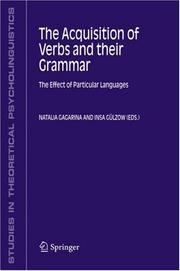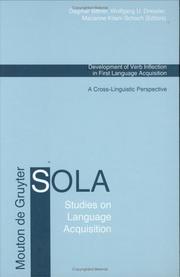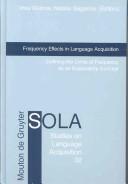| Listing 1 - 10 of 10 |
Sort by
|

ISBN: 1280624965 9786610624966 140204335X 1402043341 1402043368 Year: 2006 Publisher: Dordrecht, the Netherlands : Springer,
Abstract | Keywords | Export | Availability | Bookmark
 Loading...
Loading...Choose an application
- Reference Manager
- EndNote
- RefWorks (Direct export to RefWorks)
This volume investigates the linguistic development of children with regard to their knowledge of the verb and its grammar. The selection of papers gives empirical evidence from a wide variety of languages including Hebrew, German, Croatian, Japanese, English, Spanish, Dutch, Indonesian, Estonian, Russian and French. Findings are interpreted with a focus on cross-linguistic similarities and differences, without subscribing to either a UG-based or usage-based approach. Currently debated topics, such as the role of frequency, as well as traditional ones such as bootstrapping are integrated into the presentation of language-specific, learner-specific and more general properties of the acquisition process. The papers are united by their focus on discovering what determines rule-governed behavior in language learners who are coming to terms with the grammar of verbs.
Language acquisition. --- Grammar, Comparative and general --- Verb. --- Linguistics. --- Applied linguistics. --- Grammar. --- Psycholinguistics. --- Applied Linguistics. --- Theoretical Linguistics. --- Language, Psychology of --- Language and languages --- Psychology of language --- Speech --- Linguistics --- Psychology --- Thought and thinking --- Linguistic science --- Science of language --- Psychological aspects --- Verb --- Acquisition of language --- Developmental linguistics --- Developmental psycholinguistics --- Language development in children --- Psycholinguistics, Developmental --- Interpersonal communication in children --- Psycholinguistics --- Verb phrase --- Verbals --- Reflexives --- Acquisition --- Grammar, Comparative and general. --- Comparative grammar --- Grammar --- Grammar, Philosophical --- Grammar, Universal --- Philosophical grammar --- Philology --- Grammar, Comparative
Book
ISBN: 9027208085 9027260346 9789027260345 9789027208088 Year: 2020 Publisher: Amsterdam Philadephia
Abstract | Keywords | Export | Availability | Bookmark
 Loading...
Loading...Choose an application
- Reference Manager
- EndNote
- RefWorks (Direct export to RefWorks)
Book

ISBN: 1282456873 9786612456879 3110216175 9783110216172 9783110216165 3110216167 Year: 2009 Publisher: Berlin Boston
Abstract | Keywords | Export | Availability | Bookmark
 Loading...
Loading...Choose an application
- Reference Manager
- EndNote
- RefWorks (Direct export to RefWorks)
Language acquisition is a developmental process. Research on spontaneous processes of both children learning their mother tongue and adults learning a second language has shown that particular stages of acquisition can be discriminated. Initially, learner utterances can be accounted for in terms of a language system that is relatively simple. In studies on second language acquisition this learner system is called the Basic Variety (Klein and Perdue 1997). Utterance structure of the Basic Variety is determined by a grammar which consists of lexical structures that are constrained, for example, by semantic principles such as "The NP-referent with highest control comes first" and a pragmatic principle such as "Focus expression last". At some point in acquisition this lexical-semantic system is given up in favour of a target-like system with morpho-syntactic features to express the functional properties of finiteness, topicality, the determiner system, etc. Insights into how this process evolves may also provide an answer to the question of why it takes place. Within this functional perspective on language acquisition research focuses on questions such as the following.1. What is the driving force behind the process that causes learners to give up a simple lexical-semantic system in favour of a morpho-syntactic functional category system?2. What is the added value of morpho-syntactic properties of inflection, word-order variation, definiteness and agreement?3. Why is it that in cases of specific language impairment it is mainly morpho-syntactic properties of the target language that are affected?
Language acquisition. --- Second language acquisition. --- Second language learning --- Language acquisition --- Acquisition of language --- Developmental linguistics --- Developmental psycholinguistics --- Language and languages --- Language development in children --- Psycholinguistics, Developmental --- Interpersonal communication in children --- Psycholinguistics --- Acquisition --- Grammaticalization. --- Language Acquisition. --- Second Language Acquisition.


ISBN: 9783110899832 3110899833 3110178230 9783110178234 Year: 2011 Publisher: Berlin Boston
Abstract | Keywords | Export | Availability | Bookmark
 Loading...
Loading...Choose an application
- Reference Manager
- EndNote
- RefWorks (Direct export to RefWorks)
Book

ISBN: 9781501510151 Year: 2020 Publisher: Berlin Boston
Abstract | Keywords | Export | Availability | Bookmark
 Loading...
Loading...Choose an application
- Reference Manager
- EndNote
- RefWorks (Direct export to RefWorks)
Book

ISBN: 1282296604 9786612296604 3110217112 3110188406 9783110217117 9781282296602 9783110188400 Year: 2009 Publisher: Berlin Boston
Abstract | Keywords | Export | Availability | Bookmark
 Loading...
Loading...Choose an application
- Reference Manager
- EndNote
- RefWorks (Direct export to RefWorks)
This book deals with the emergence of nominal morphology from a cross-linguistic perspective and is closely related to Development of Verb Inflection in First Language Acquisition (ed. by D. Bittner, W. U. Dressler, M. Kilani-Schoch) both methodologically and theoretically. Each of the fourteen contributions studies the early development of the fundamental inflectionally expressed categories of the noun (number, case, gender) in one of the languages belonging to different morphological types (isolating, fusional-inflecting, agglutinating, root inflecting) and families (Germanic, Romance, Slavic/Baltic, Greek, Finnic, Turc, Semitic, Indian American). The analyses are based on parallel longitudinal observations of children in their second and early third year of life as well as their input. The focus lies on the transition from a pre-morphological to a proto-morphological stage in which grammatical oppositions and so-called "mini-paradigms" begin to develop. The point at which children start to discover the morphological structure of their language and the speed with which they develop inflectional distinctions of lexical items has been found to be dependent on the morphological richness of the input language on the paradigmatic as well as the syntagmatic axis of linguistic structure. The findings are interpreted within non-nativist theoretical frameworks (Natural Morphology, Usage-based theories).
Grammar, Comparative and general --Inflection. --- Grammar, Comparative and general --Noun. --- Language acquisition. --- Languages, Modern --Inflection. --- Languages, Modern --- Grammar, Comparative and general --- Language acquisition --- Western European Languages - General --- Languages & Literatures --- Inflection --- Noun --- Inflection. --- Noun. --- Acquisition of language --- Developmental linguistics --- Developmental psycholinguistics --- Language and languages --- Language development in children --- Psycholinguistics, Developmental --- Inflectional morphology --- Acquisition --- Interpersonal communication in children --- Psycholinguistics --- Nominals --- Morphology --- Kasus. --- LANGUAGE ARTS & DISCIPLINES --- Numerus. --- Spracherwerb. --- Linguistics --- Morphology. --- Grammar --- Philology --- Case. --- Language Acquisition. --- Number.


ISSN: 18614248 ISBN: 3110196719 9783110196719 3110977907 9783110977905 Year: 2011 Volume: 32 Publisher: Berlin Boston
Abstract | Keywords | Export | Availability | Bookmark
 Loading...
Loading...Choose an application
- Reference Manager
- EndNote
- RefWorks (Direct export to RefWorks)
The book addresses a controversial current topic in language acquisition studies: the impact of frequency on linguistic structure in child language. A major strength of the book is that the role of input frequency in the acquisition process is evaluated in a large variety of languages, topics and the two major theoretical frameworks: UG-based and usage-based accounts. While most papers report a clear frequency effect, different factors that may be interacting with pure statistical effects are critically assessed. An introductory statement is made by Thomas Roeper who calls for caution as he id
Frequency (Linguistics). --- Language acquisition. --- Psycholinguistics. --- Language acquisition --- Frequency (Linguistics) --- Languages & Literatures --- Philology & Linguistics --- Lexicology. Semantics --- Psycholinguistics --- Grammar --- Frequency of occurrence (Linguistics) --- Acquisition of language --- Developmental linguistics --- Developmental psycholinguistics --- Language and languages --- Language development in children --- Psycholinguistics, Developmental --- Acquisition --- Linguistic analysis (Linguistics) --- Interpersonal communication in children --- Language acqusition, Theories of Language Acquisition.
Book

ISBN: 9781501514562 9781501505492 9781501505423 1501514563 1501505491 1501505424 9781501505508 1501505505 Year: 2017 Volume: 55 Publisher: Berlin Boston
Abstract | Keywords | Export | Availability | Bookmark
 Loading...
Loading...Choose an application
- Reference Manager
- EndNote
- RefWorks (Direct export to RefWorks)
Although usage-based approaches have been successfully applied to the study of both first and second language acquisition, to monolingual and bilingual development, and to naturalistic and instructed settings, it is not common to consider these different kinds of acquisition in tandem. The present volume takes an integrative approach and shows that usage-based theories provide a much needed unified framework for the study of first, second and foreign language acquisition, in monolingual and bilingual contexts. The contributions target the acquisition of a wide range of linguistic phenomena and critically assess the applicability and explanatory power of the usage-based paradigm. The book also systematically examines a range of cognitive and linguistic factors involved in the process of language development and relates relevant findings to language teaching. Finally, this volume contributes to the assessment and refinement of empirical methods currently employed in usage-based acquisition research. This book is of interest to scholars of language acquisition, language pedagogy, developmental psychology, as well as Cognitive Linguistics and Construction Grammar.
Psycholinguistics --- Comparative linguistics --- Didactics of languages --- Language acquisition. --- Acquisition of language --- Developmental linguistics --- Developmental psycholinguistics --- Language and languages --- Language development in children --- Psycholinguistics, Developmental --- Interpersonal communication in children --- Acquisition --- Cognitive linguistics --- Language acquisition --- Second language acquisition --- Cognitive grammar --- Construction grammar --- Children --- Cognitive grammar. --- Construction grammar. --- Second language acquisition. --- Study and teaching --- Usage --- Language --- Language. --- Study and teaching. --- Usage. --- Cognitive Linguistics. --- Language Acquisition. --- Language Teaching. --- Usage-Based Approaches.
Book

ISBN: 1283430371 9786613430373 3110259176 9783110259179 9783110238723 3110238721 Year: 2011 Publisher: Berlin Boston
Abstract | Keywords | Export | Availability | Bookmark
 Loading...
Loading...Choose an application
- Reference Manager
- EndNote
- RefWorks (Direct export to RefWorks)
The workshop Production-Comprehension Asymmetries in Child Language held in Osnabrück in 2009 is the starting point for this book. The workshopdeveloped fromthe observation that children's production skills appear to precede their comprehension skills in a number of phenomena, e.g. pronouns or negation. The volume provides cross-linguistic evidence for such asymmetric development and investigates grammatical and methodical explanations of the observed asymmetries.
Children --- Language acquisition. --- Acquisition of language --- Developmental linguistics --- Developmental psycholinguistics --- Language and languages --- Language development in children --- Psycholinguistics, Developmental --- Interpersonal communication in children --- Psycholinguistics --- Language. --- Acquisition --- Vocabulary --- Language acquisition --- Language --- Child Language Development. --- Language Acquisition.
Book

ISBN: 9783110911466 Year: 2011 Publisher: Berlin Boston
Abstract | Keywords | Export | Availability | Bookmark
 Loading...
Loading...Choose an application
- Reference Manager
- EndNote
- RefWorks (Direct export to RefWorks)
| Listing 1 - 10 of 10 |
Sort by
|

 Search
Search Feedback
Feedback About UniCat
About UniCat  Help
Help News
News